Surviving Phuket’s rip currents: everything has changed
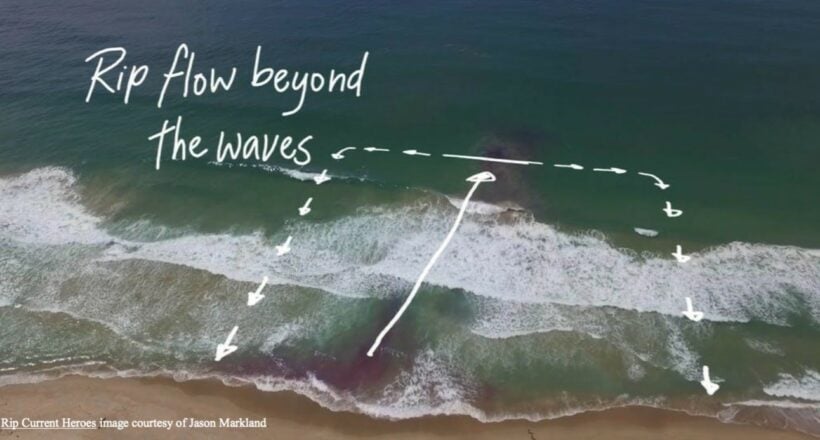
(12 minute read)
By Associate Professor Robert Brander, PhD, Coastal Geomorphologist, University of New South Wales, Sydney, Australia Daren Jenner, Marine Safety Officer, International Surf Lifesaving Association.
Rip currents are strong, narrow seaward flowing currents, like ‘rivers of the sea’, that exist on many beaches when waves are breaking across wide areas. These potentially deadly currents are also responsible for the vast majority of beach rescues by lifeguards around the world, and are the main cause of beach related drownings. Phuket is no exception, as rip currents exist on many beaches during the monsoon season from May to November, and numerous people, usually tourists, have been caught in rips and drowned.
Unfortunately, studies have shown that many people have a poor understanding of what rip currents are, and more than two-thirds of beachgoers can’t identify what rip currents look like. In Phuket, due to the high transient tourist population, this number is likely much higher.
New information brought to light by recent scientific research and experiments in rip currents, now reveals that much of what experts used to believe about them is oversimplified, and has significant implications for how people should actually react if they find themselves caught in a rip current.
“…It’s changed everything about what we thought we knew about rip currents.” Dr. Robert Brander, PhD, aka “Dr. Rip”.
What is a rip current?
“Rip currents are strong, narrow, seaward flowing currents, that extend from the shoreline, out beyond the breaking waves. They exist to bring all the extra water that is coming in with the breaking waves, back off- shore,” explains Dr. Robert Brander, a coastal scientist from the Univeristy of New South Wales in Sydney, Australia.
“The traditional diagrams about how water flows and circulates in a rip have been in use for decades and typically show rip currents flowing straight out to sea, well offshore of the breaking waves. However, recent advances in measuring rips have shown that the old scientific view may not always be an accurate depiction of how rip currents actually work. Many rips in fact circulate within the surf zone and only extend beyond it occasionally. This suggests that floating, instead of swimming parallel to the beach, may be the best action to take if caught in a rip” says Dr Brander.
“With this new scientific information, we have learned that our old ideas, and the strategies we used to teach about effectively escaping rip currents, may need to be reconsidered. New rip current safety and escape advice is urgently needed. Getting this information right, and in the hands of the beachgoing public now, could save hundreds of lives every year,” according to Daren Jenner, an ocean lifeguard and Marine Safety Officer for the International Surf Life Saving Association (ISLA).

Traditional diagram of rip current flow showing the accepted escape action of swimming parallel to the beach. New research shows that not all rips flow like this. (Image: NOAA).
Prevention
The first and best strategy for swimmers to use to survive rip currents is prevention. The only effective method to keep ocean users safe from rips one- hundred-percent of the time, is to avoid them completely. Swimming at a beach patrolled by certified ocean lifeguards, and knowing how to spot these currents yourself, are the two most important actions anyone can take to avoid drowning in rips.
Trained lifeguards in Phuket mark safe swimming areas with a pair of red-and- yellow flags. Staying in-between these flags while in the water is the best way to avoid rip currents on the Island. If a lifeguarded beach in Phuket does not have these flags flying, beach users are advised not to enter the water and if they do, not to go beyond waist depth.
Having basic rip current knowledge can definitely help those in distress choose the best escape strategy. Frequent beach swimmers, and those attending unguarded beaches, have a better chance of successfully rescuing themselves, if they have learned about rip currents before visiting the beach.
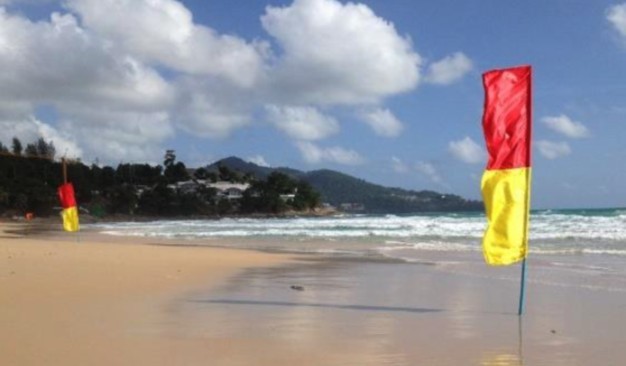
A safe swimming area is marked by red-and-yellow flags at Surin Beach, Phuket, Thailand. Photo: International Surf Lifesaving Association
“Rip currents are much more complex than we previously believed. Advising swimmers how to choose the best strategy to break the grip of the rip has also become more complex.”
The challenges
Replacing outdated information with updated rip current escape strategies that are more effective poses a challenge for water safety experts. New scientific research has shown that rip currents are much more complex than previously believed, and advising swimmers how to choose the best strategy to break the grip of the rip has also become more complex.
The reality is that swimmers caught in a rip may need to make a series of decisions to escape, rather than simply remembering the old slogan of “swimming parallel to the shore in either direction.” Escaping rips may require a combination of floating and swimming.
However, stress and panic can make it extremely difficult for a person in distress to assess their situation, and then make a series of correct decisions about what to do. Plus, respiratory impairment and resulting “air hunger” can negatively affect our decision-making abilities. A major contributor in rip current drownings is the natural panic response.
The challenge for beach users that need to self-rescue is they must remain calm, float to conserve energy, and assess their situation. It is imperative to avoid the natural urge to swim against the current back to shore. This is so important because it is panic that drowns people, not rip currents. Rips do not pull people under the water, or take them across the ocean, they simply take people for a ride.
If a beachgoer does enter the water at a secluded or unguarded beach, and finds themselves being pulled out by a rip, it may be necessary for them to try and help themselves.
If there are surfers or competent beach swimmers nearby, wave your hand and call for help. You can also try to signal people on the shore. For those on the beach who see someone in trouble in the water, it is important for them first to alert someone to seek help, or to phone an emergency number. If a person on the beach chooses to enter the water to help, it is essential that they bring a flotation device with them.
For many people caught in rip currents, however, often the only option is to perform a self-rescue.
How to self-rescue from a rip
- Relax. The rip current won’t pull you under, it just takes you for a ride
- Stay afloat and think about your situation. If there are lifeguards or surfers around, signal for help. Or get the attention of someone on the beach who can go seek help
- You can choose to keep floating as there is a chance the rip current flow may re-circulate back into shallow water in 5-10 minutes. You are also conserving your energy
- If you want to swim out of the rip current, look around you for the nearest area of breaking waves and whitewater. Most rips are quite narrow and the whitewater means it’s shallower and you may be able to stand up
- Conserve energy by swimming slowly towards that area. If no progress is being made, swim in another direction towards the next-closest shallow area with breaking waves. Once the waves start to break around you, swim with them toward the beach. When you can touch the bottom, walk to shore, avoiding deeper water if possible.
Types of rip currents and how to spot them
You don’t cross a road without looking both ways and you should never go to a beach with lots of waves without thinking about rip currents. Always spend five minutes looking at the surf trying to spot rips, or ask a lifeguard or surfer if there are any rip currents present and get them to point them out to you.
Rip currents sometimes circulate as rotating eddies, in which case floating is a good escape strategy. They can also extend well beyond the line of breaking waves, in which case a long swim along the beach is required to make it back to shore.
Always spend five minutes looking at the surf trying to spot rips, or ask a lifeguard or surfer if there are any rip currents present and get them to point them out to you.

LEFT: Channelised rip current with a rotating eddy circulation. RIGHT: Channelised rip that extends beyond the surf zone. Rip Current Heroes images courtesy of Jason Markland.
However, one of the reasons why rip currents are so complex and dangerous is that there are different types, and some look considerably different than others. Some are also easier to spot than others. Here is a quick guide on how to spot rips when you go to the beach.
Channelised rips
Many rip currents occupy deeper channels of water between shallow sandbars. These channelised rip currents can stay in the same place for days, weeks, or months, and are the easiest to spot. They appear as regions of darker, seemingly calmer, water between areas of breaking waves and whitewater. They can also erode large scalloped embayments along the beach.
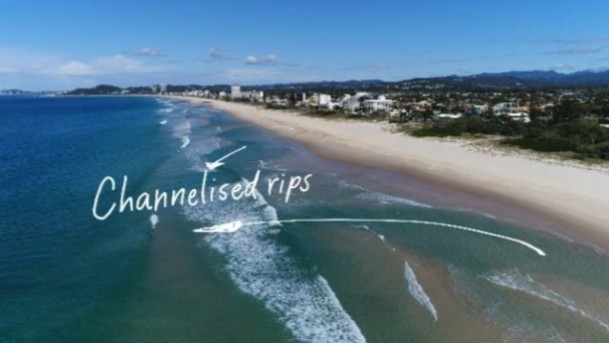
Two channelised rip currents flowing at different angles to the beach. Rip Current Heroes image courtesy of Jason Markland.
Boundary rips
Boundary rips are also channelised and flow alongside jetties, piers, groins, headlands, and other physical structures in the water. They also appear as darker gaps of water. These rips are particularly dangerous because they can be flowing in the same location most, if not all of the time.
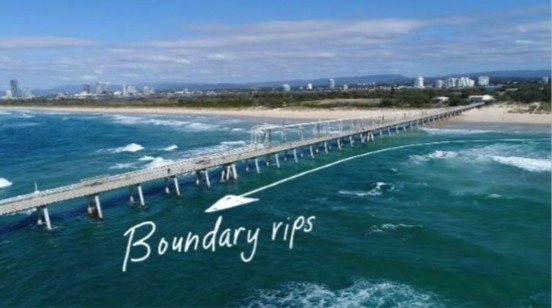
A boundary rip along a pier. Rip Current Heroes images courtesy of Jason Markland.
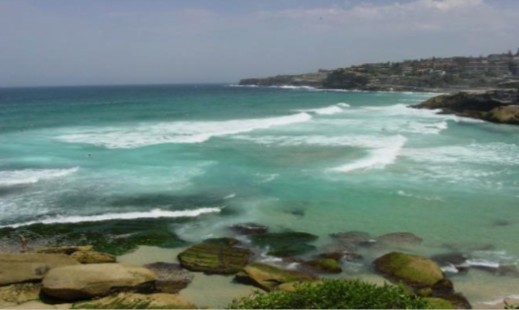
A boundary rip created by a headland. Image courtesy of Robert Brander.
Flash rips
One of the most dangerous and unpredictable types of rip are flash rips. Flash rips are not channelised and do not appear as dark gaps of water. They can occur suddenly and can be short-lived and are formed when a sudden group of larger (set) waves break causing the excess of water to flow seawards. Flash rips often pulse, and can vary in strength, depending on the size and number of set waves that occur. Once the set of larger waves diminishes, flash rips can suddenly disappear, only to reappear later in another location.
To learn more about flash rips, and to see a collection of images and descriptions of rip currents, visit www.scienceofthesurf.com/ripom.html
Take-away message
Beaches are beautiful places and should be enjoyed, but they can also be dangerous. It just takes a little bit of awareness to ensure a safe trip to the beach. First, always think about beach safety when you visit a beach. When you arrive on the beach, spend a few minutes asking yourself some questions. Are there lifeguards around? Are the waves big and breaking in many places? Are there any rip currents around? Am I a good enough swimmer for these conditions? You should never go in the water if there are lots of big waves breaking and you are not a confident swimmer. Second, if you are not a good swimmer, don’t go in past your waist. Always make sure you’ve got your feet firmly planted on some sand.
Finally, always look after your family members and friends who are swimming. Stop them from getting into trouble before it happens.
About the Authors

Dr. Rob Brander is a coastal geomorphologist and Associate Professor in the School of Biological, Earth and Environmental Sciences at the University of New South Wales in Sydney, NSW, Australia. He has been studying beaches and surf science since 1986.
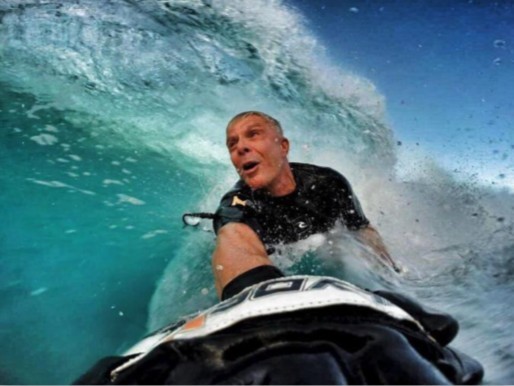
Daren Jenner is a bodysurfer and ocean lifeguard in SE Asia. He is also a Marine Safety Officer for the International Surf Lifesaving Association.
Latest Thailand News
Follow The Thaiger on Google News:


























